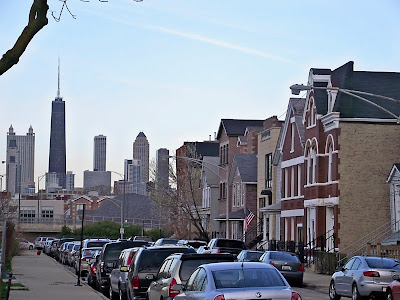The Breakdown
An overview: The West Loop is one of the great Chicago neighborhood success stories of the past few decades. A dangerous industrial wasteland as recently as the late 1980s, today the West Loop hosts a bevy of upscale residences and some of the nation’s most well-known and highly regarded restaurants. Love her or loathe her, Oprah Winfrey’s sphere of influence takes much of the credit. She curiously chose this area as the home of Harpo Studios in the mid-80s. Her television program quickly became a tourist destination and an economic development tool for the West Loop. Today, the neighborhood boasts numerous shops and dining establishments that have followed the successes of those before them, sprouting up around the home of Ms. Winfrey’s empire.
| The West Loop, where today meets the 70s...the 1870s. |
The West Loop is also home to Greektown, a small but wonderful ethnic strip along Halsted. There are more than enough places to eat and drink in Greektown alone, so we’ll save that one for another entry.
The boundaries: Although adjacent to the Loop, the West Loop is located mostly within the Near West Side community area, however a small northern portion also resides in the West Town community area. Its unofficial boundaries are usually regarded as Grand Avenue to the north, the Eisenhower Expressway to the south (I-290), Ashland Avenue to the west, and the Chicago River to the east.
Population make-up: The West Loop consists essentially of four census tracts: 2801, 2819, 8330, and 8331. Unfortunately the latter two tracts don’t seem to have data available on the American Factfinder website. Even though most of the West Loop is within the Near West Side, it’s such a diverse community area that it’s not reasonable to speculate demographics based on the data from the whole community area. Sorry, we’re going to have to leave this one blank.
| The House that Oprah Built...figuratively speaking. |
But this is not the only history seen in the West Loop. It was also the host of the Haymarket Square Riot of 1886 that saw a peaceful labor demonstration turn violent. The neighborhood has been an industrial district (especially meat-packing) since its foundation. However, the last two decades have seen revolutionary change. What was fairly recently a neighborhood that you didn’t venture to after dark is now home to condominiums and some of Chicago’s most noteworthy restaurants. It’s here you’ll find arguably the most hyped-up restaurant in the City’s history: Next. You’ll also find other highly acclaimed restaurants like Moto, Blackbird, and a few others you may have heard of, but we’re getting to that…
Getting there: Plenty of ways. Via “L”, the Green Line has stops at Clinton to the northeast and Ashland to the northwest. The Blue Line has three stops along the neighborhood’s southern boundary (from east to west): Clinton, UIC-Halsted, and Racine. By Metra rail, you can visit the West Loop at Union Station or the Ogilvie Transportation Center.
By bus there are also many options. Travelling east-west throughout the entire neighborhood: Grand (65), Madison (20), and Jackson/Van Buren (126). East of the Kennedy (I-90/94), there are many other options, but it’s probably best to visit the CTA website than just taking it from us. Going north-south, you have bus options along Halsted (8) and Ashland (9).


